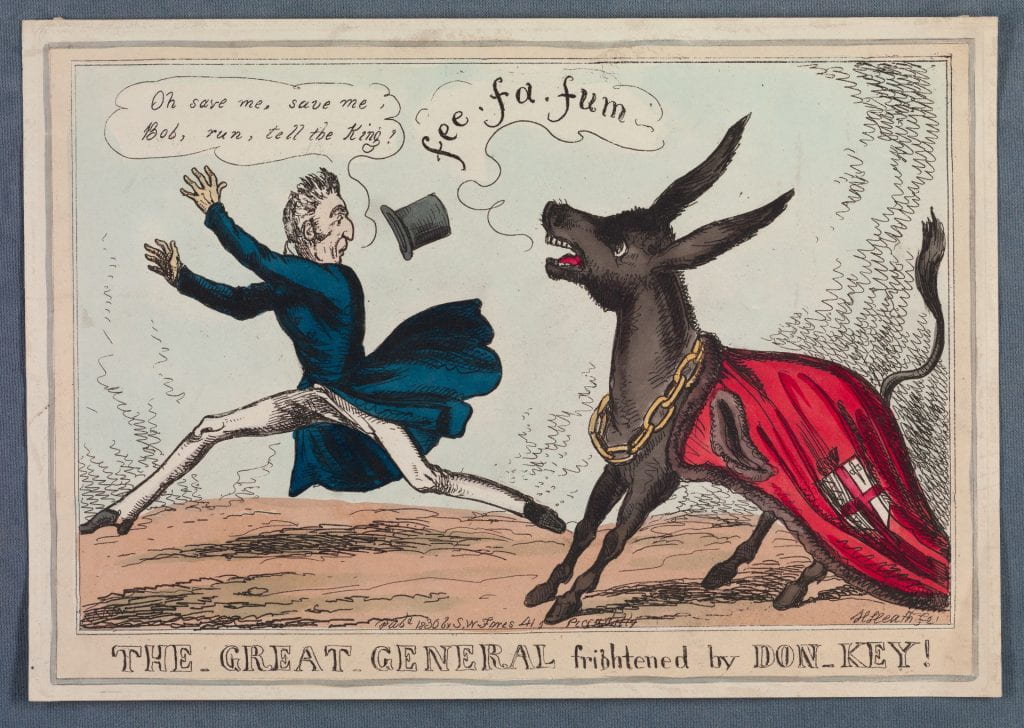
“Plate from the ‘Satirist’, xiii. 193. In the text the title continues ‘. . ., “alias” War’. A satire on the Congress of Prague. Four sovereigns, completely unlike the men in question, in conference. The Tsar sits behind a small rectangular table on which are displayed implements of war in miniature: cannon, pyramids of cannon-balls, muskets, swords, drums, &c., and flags on one of which are fleurs-de-lis. On the left stand the King of Prussia and the Emperor of Austria, on the right is Napoleon. Alexander extends his hands rhetorically, turning to the left, with a puckered scowl, to say to the two Germans: “Come Gentlemen see first if you can agree–if not we’ll all fight!” He has quasi-Kalmuck features, and wears an odd-shaped crown, an ermine-bordered robe, with a jewelled necklace and a Greek cross. Frederick William III, on the extreme left, clutches the hilt of his sword and puts his left hand to his cocked hat as if ready to doff it, he turns to Francis I, towards whom a label issues from his mouth: “I am ready to treat or to fight”; a second label floats to the left, inscribed ‘Infernal Scoundrel’. Francis I, looking distracted, stands directed to the right, legs apart, and in his left hand is his sabre, the blade of which curves over the Tsar’s head, but both hands touch his crown, and he says: “I will wear an independant Crown.” He wears hussar uniform, cloak, sash, and elaborately embroidered tunic and pantaloons. Napoleon, tall and burly, with heavy whisker and aquiline profile, wears a plumed bicorne with tricolour cockade and very tattered uniform leaving his legs almost bare, with one dilapidated jack-boot and one damaged stocking; he has a long sword. He stands aggressively with arms dramatically extended, saying, “My Friends! all we wish is Peace.” A chain is attached to each great toe, which is fastened to the necks of two miserable princes, tiny figures standing between his outstretched legs. One (left), Charles IV of Spain, wearing a crown and robe, grotesquely knock-kneed and despairing, stands full-face. The other, wearing a crown with uniform and sword, stoops in profile, looking up abjectly at Napoleon’s legs. On the extreme right, in the middle distance, is a tall Spanish don, much emaciated, wrapped in a cloak. He looks down with folded arms at a fat British officer beside him, who says: “I ll countenance Austria into our interests.” The Spaniard: “I’ll be damned if I go to meet a Frenchman in Prague, while there is a Frenchman to meet in Spain!!!” Behind them in the background a tiny Napoleon, wearing a grotesque crown and holding a sword, marches downhill at the head of his soldiers carrying flags; he has a melancholy expression and approaches the edge of a precipitous descent.”–British Museum online catalogue.
- Printmaker: Brooke, William Henry, 1772-1860, printmaker, artist.
- Title: A congress for peace [graphic] / Satirist invt. ; W.H. Ekoorb [that is, Brooke] delt. et fecit.
- Publication: [London] : [publisher not identified], [1 September 1813]
813.09.01.02
Acquired September 2023

